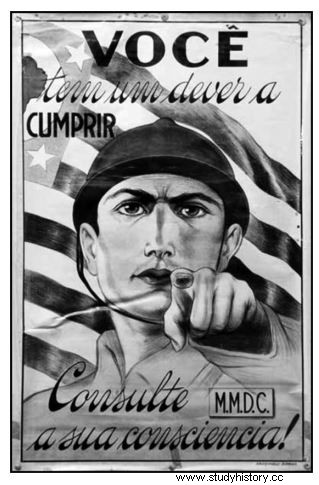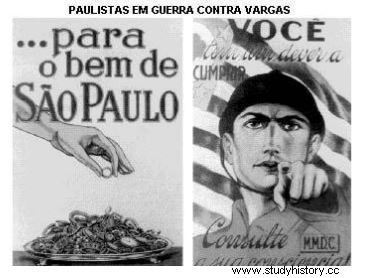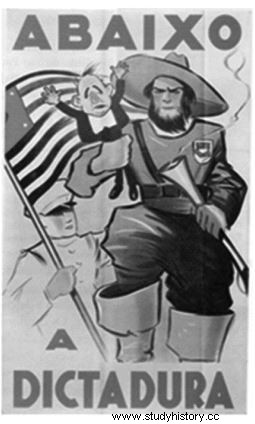
This image is directly related to the
a) campaign for industrialization in Brazil.
b) Brazil's participation in World War I.
c) Revolution of 1932.
d) Brazil's participation in World War II.
e) Nationalist reaction to the 1964 coup .
Question 02 - UNESP 2010 (History) - About the constitutionalist movement of 1932, it is possible to affirm that
a) it was the result of the federal policy, which prevented the export of coffee from São Paulo to the European West.
b) it delayed the Brazilian democratization process undertaken by Getúlio Vargas from 1930 onwards.
c) had, as main objective, the separation of the state of São Paulo from the rest of the federation.
d) led the federal government to negotiate with the São Paulo oligarchy and to make concessions to their interests.
e) was successful, defeating Vargas' troops and returning the presidency to coffee growers.
Question 03 - SEDUC - CE - 2016 - SEDUC-CE - Professor - History - Read the text below. In 1932, the state of São Paulo mobilized against Vargas, in the episode that entered the history of Brazil as the Constitutionalist Revolution. In this revolution, thousands of people from all social classes donated silverware, jewelry and rings to financially help the movement. The entire state, united, worked with determination for the victory of the São Paulo cause.

In this context, we can explain the Constitutionalist Revolution of 1932 as a) the lieutenants' discontent with the repression unleashed on them, after the movement of 1930.b) the popular revolt against the imposed authoritarian determinations, after the decree of the Estado Novo.c) the reaction of the Paulistas, facing the loss of hegemony in national politics, after the Revolution of 1930. d) the coup attempt to seize power and the installation of socialism, led by Luiz Carlos Prestes. e) the articulation of the highest levels of the Armed Forces against the expansion of political freedoms.
Question 04 - MPE- GO - 2017 - MPE-GO - Assistant Secretary - In Brazil, after the end of the period known as the First Republic, Getúlio Vargas rose to power, remaining in it for approximately 15 years, successively exercising the function of head of a provisional government, president elected by indirect vote and dictator. The period of Vargas' Provisional Government is marked by some revolutions, among them what became known as the Constitutionalist Revolution of 1932, or just the Revolution of 1932. Regarding the 1932 revolution, we can assert that:a) It was the armed movement that took place in state of São Paulo that aimed to overthrow the provisional government of Getúlio Vargas and the convening of a National Constituent Assembly b) It was the confrontation between the Brazilian Army and the members of a popular social-religious movement led by Antônio Conselheiro, then in the community of Canudos, in the interior of the state of Bahia, in northeastern Brazilc) It was the armed movement, led by the states of Minas Gerais, Paraíba and Rio Grande do Sul, which culminated in the coup d'état that deposed the president of the republic Washington Luís and prevented the inauguration of the president-elect Júlio Prestesd) It was the political-military movement that started a series of rebellions by young officers of low and medium rank of the Brazilian Army unhappy with the political situation in Brazil. They proposed reforms in the country's power structure, among which the end of the open vote (end of the halter vote), the institution of the secret ballot and the reform in public education stand out. government of the democratically elected president João Goulart, also known as Jango.
Question 05 - PUCRS 2000.1 - It is correct to indicate as causes of the Constitutionalist Revolution of 1932 A) the demand for a new Constitution for the country, the end of the Provisional Government and the opposition of the São Paulo oligarchy to the political centralization promoted by Vargas. B) maintenance of the provisional government, dissatisfaction with the Constituent Assembly called by the government and opposition to fiscal centralization by the federal government. C) the demand for a new Constitution for the country, the maintenance of the provisional government and the opposition to fiscal centralization by the federal government. D) the desire to convene a State Constituent Assembly, criticism of the provisional government and opposition to the political centralization promoted by Vargas. E) the demand for support for coffee production, the demand for greater participation by São Paulo in the federal government and the desire to convene a State Constituent.
Question 06 - UTFPR 2008 - Summer - 2nd test /Group 4 -When Getúlio Vargas came to power, after the 1930 coup, he appointed a non-Paulista intervenor to direct São Paulo. This upset the Paulistas, especially the leaders of the Paulista Republican Party (PRP), and was the origin of:
A) National Liberation Alliance.
B) Prestes Column.
C) Constitutionalist Revolution.
D) Communist Intent.
E) Creation of the New State.
Question 07 - MACKENZIE 2003 - When you feel the heroic blow on your chest
Leave the sheet folded
While you are going to die Tobias Barreto
The “Paulista War” of 1932 sought, in poetry, to the symbols for their revolt. About this movement, we can say that:
a) it had massive support from the urban and rural proletariat.
b) it had no identification with the middle classes and their social aspirations.
c) the people of São Paulo they feared the postponement of the elections, the establishment of the dictatorship and sought to recover the political hegemony lost in 1930.
d) the movement obtained the support of all the states, forcing Vargas to lay down arms.
e) although victorious , the people of São Paulo did not obtain their political claim, the Constitution.
Question 08 - UEPB 2013 - After the Constitutionalist Revolution of 1932, we experienced the "Constitutionalist Period" (1934/1937). In 1934, the National Constituent Assembly was installed, in which Carlota Pereira de Queirós (the only woman among the constituents), the first federal deputy in Brazil, participated. Mark the only INCORRECT alternative.
a) The 1934 Constitution incorporated the labor legislation, already in force, and even added the institution of the minimum wage. It also created the Labor Court. But the new letter still did not recognize the right to vote for illiterates and soldiers.
b) The promulgation of the 1934 Constitution was unequivocal proof that Brazil was moving towards the implementation of a solid democratic system.While in Europe totalitarian dictatorships were taking root in power, in Brazil, elections were held, the constitution was promulgated and individual freedoms were increased.
c) With the promulgation of the new Constitution and the election of Getúlio Vargas, when the Once the provisional government that had been in place since 1930, Brazil saw the emergence of two antagonistic movements:the National Liberation Alliance (ANL) and the Brazilian Integralist Action (AIB).
d) More striking than the 1934 National Constituent Assembly itself. it was the fact that women had won the right to vote. The struggle of Brazilian suffragettes, which began in the 20th century, finally achieved a feat at the national level.
e) Even with a promulgated Constitution and an elected government, in Brazil all they thought about was coups and revolutions. In 1935 communist military or not promote an insurrection to overthrow the federal government and implant communism in Brazil.
Question 09 - UFPR 2013 - Based on the figure on the side, published in 1932, consider the following statements:

1. The figure refers to the Constitutionalist Revolution, in which the Paulistas demanded from the Vargas government the implementation of a democratic Constitution. 2. In the context of 1932, the image of the bandeirante served as propaganda to show that the Paulistas were averse to submission to a tyrant, just as the bandeirantes would have been averse to the tyranny of the Portuguese Crown. 3. The so-called Revolution of 1932 culminated in the defeat of the Paulistas by Vargas' forces and with the continuation of the Estado Novo. 4. Despite the defeat of the Paulistas, one of the main consequences of the 1932 movement was the promulgation of the 1934 Constitution. Choose the correct alternative. a) Only statements 1 and 3 are true. b) Only statements 1 and 2 are true. c) Only statements 1, 2 and 4 are true. d) Only statements 1, 2 and 3 are true. e) Only statements 2, 3 and 4 are true.
Question 10 - UNESP - 2011/2 - 1st day - The constitutionalist movement of 1932, in São Paulo, can be interpreted as a
a) attempt to prevent the advance of radical right-wing political projects in the country.
b) dispute between hegemonic social groups in Brazil since the end century.
c) reaction of the São Paulo oligarchy against the socialist measures taken by the government of Getúlio Vargas.
d) popular mobilization against the power of the coffee elite that dominated the country.
e) Defense of the economic interests of southeastern Brazilian states against northeastern hegemony.
Question 11 - UNESP - 2009 - 1st day - A poster alluding to the 1932 Revolution contained the message “You have a duty to fulfill”, which called
a) the gauchos to defend the provisional government of Vargas, threatened by the separatist forces of the states.
b ) the people of São Paulo and the inhabitants of the state of São Paulo to fight for the constitutionalization of the country.
c) the young people to join the Brazilian Expeditionary Force, in the fight against Nazi-fascism.
d) the workers to mobilize for labor legislation, whose project was vetoed by the National Congress. e) entrepreneurs to defend the free economic initiative, threatened by the government of the Liberal Alliance.
GABARITO
01 - C
02 - D
03 - C
04 - A
05 - A
06 - C
07 - C
08 - B
09 - C
10 - B
11 - B
